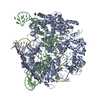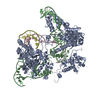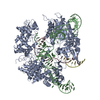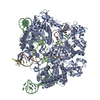+ Open data
Open data
- Basic information
Basic information
| Entry |  | |||||||||
|---|---|---|---|---|---|---|---|---|---|---|
| Title | SpG Cas9 with NGC PAM DNA target | |||||||||
 Map data Map data | ||||||||||
 Sample Sample |
| |||||||||
 Keywords Keywords | SpG-Cas9 / CRISPR / Cas9 / IMMUNE SYSTEM / R-loop / IMMUNE SYSTEM-RNA-DNA complex | |||||||||
| Function / homology |  Function and homology information Function and homology informationmaintenance of CRISPR repeat elements / 3'-5' exonuclease activity / DNA endonuclease activity / defense response to virus / Hydrolases; Acting on ester bonds / DNA binding / RNA binding / metal ion binding Similarity search - Function | |||||||||
| Biological species |  Streptococcus pyogenes (bacteria) / synthetic construct (others) Streptococcus pyogenes (bacteria) / synthetic construct (others) | |||||||||
| Method | single particle reconstruction / cryo EM / Resolution: 3.56 Å | |||||||||
 Authors Authors | Bravo JPK / Hibshman GN / Taylor DW | |||||||||
| Funding support |  United States, 2 items United States, 2 items
| |||||||||
 Citation Citation |  Journal: Nat Commun / Year: 2024 Journal: Nat Commun / Year: 2024Title: Unraveling the mechanisms of PAMless DNA interrogation by SpRY-Cas9. Authors: Grace N Hibshman / Jack P K Bravo / Matthew M Hooper / Tyler L Dangerfield / Hongshan Zhang / Ilya J Finkelstein / Kenneth A Johnson / David W Taylor /   Abstract: CRISPR-Cas9 is a powerful tool for genome editing, but the strict requirement for an NGG protospacer-adjacent motif (PAM) sequence immediately next to the DNA target limits the number of editable ...CRISPR-Cas9 is a powerful tool for genome editing, but the strict requirement for an NGG protospacer-adjacent motif (PAM) sequence immediately next to the DNA target limits the number of editable genes. Recently developed Cas9 variants have been engineered with relaxed PAM requirements, including SpG-Cas9 (SpG) and the nearly PAM-less SpRY-Cas9 (SpRY). However, the molecular mechanisms of how SpRY recognizes all potential PAM sequences remains unclear. Here, we combine structural and biochemical approaches to determine how SpRY interrogates DNA and recognizes target sites. Divergent PAM sequences can be accommodated through conformational flexibility within the PAM-interacting region, which facilitates tight binding to off-target DNA sequences. Nuclease activation occurs ~1000-fold slower than for Streptococcus pyogenes Cas9, enabling us to directly visualize multiple on-pathway intermediate states. Experiments with SpG position it as an intermediate enzyme between Cas9 and SpRY. Our findings shed light on the molecular mechanisms of PAMless genome editing. | |||||||||
| History |
|
- Structure visualization
Structure visualization
| Supplemental images |
|---|
- Downloads & links
Downloads & links
-EMDB archive
| Map data |  emd_41775.map.gz emd_41775.map.gz | 204 MB |  EMDB map data format EMDB map data format | |
|---|---|---|---|---|
| Header (meta data) |  emd-41775-v30.xml emd-41775-v30.xml emd-41775.xml emd-41775.xml | 21 KB 21 KB | Display Display |  EMDB header EMDB header |
| Images |  emd_41775.png emd_41775.png | 34.9 KB | ||
| Filedesc metadata |  emd-41775.cif.gz emd-41775.cif.gz | 7.4 KB | ||
| Others |  emd_41775_half_map_1.map.gz emd_41775_half_map_1.map.gz emd_41775_half_map_2.map.gz emd_41775_half_map_2.map.gz | 200.2 MB 200.2 MB | ||
| Archive directory |  http://ftp.pdbj.org/pub/emdb/structures/EMD-41775 http://ftp.pdbj.org/pub/emdb/structures/EMD-41775 ftp://ftp.pdbj.org/pub/emdb/structures/EMD-41775 ftp://ftp.pdbj.org/pub/emdb/structures/EMD-41775 | HTTPS FTP |
-Related structure data
| Related structure data |  8tzzMC  8spqC  8sqhC  8srsC  8t6oC  8t6pC  8t6sC  8t6tC  8t6xC  8t6yC  8t76C  8t77C  8t78C  8t79C  8t7sC  8u3yC M: atomic model generated by this map C: citing same article ( |
|---|---|
| Similar structure data | Similarity search - Function & homology  F&H Search F&H Search |
- Links
Links
| EMDB pages |  EMDB (EBI/PDBe) / EMDB (EBI/PDBe) /  EMDataResource EMDataResource |
|---|---|
| Related items in Molecule of the Month |
- Map
Map
| File |  Download / File: emd_41775.map.gz / Format: CCP4 / Size: 216 MB / Type: IMAGE STORED AS FLOATING POINT NUMBER (4 BYTES) Download / File: emd_41775.map.gz / Format: CCP4 / Size: 216 MB / Type: IMAGE STORED AS FLOATING POINT NUMBER (4 BYTES) | ||||||||||||||||||||||||||||||||||||
|---|---|---|---|---|---|---|---|---|---|---|---|---|---|---|---|---|---|---|---|---|---|---|---|---|---|---|---|---|---|---|---|---|---|---|---|---|---|
| Projections & slices | Image control
Images are generated by Spider. | ||||||||||||||||||||||||||||||||||||
| Voxel size | X=Y=Z: 0.833 Å | ||||||||||||||||||||||||||||||||||||
| Density |
| ||||||||||||||||||||||||||||||||||||
| Symmetry | Space group: 1 | ||||||||||||||||||||||||||||||||||||
| Details | EMDB XML:
|
-Supplemental data
-Half map: #1
| File | emd_41775_half_map_1.map | ||||||||||||
|---|---|---|---|---|---|---|---|---|---|---|---|---|---|
| Projections & Slices |
| ||||||||||||
| Density Histograms |
-Half map: #2
| File | emd_41775_half_map_2.map | ||||||||||||
|---|---|---|---|---|---|---|---|---|---|---|---|---|---|
| Projections & Slices |
| ||||||||||||
| Density Histograms |
- Sample components
Sample components
-Entire : SpG Cas9 with NGG PAM target
| Entire | Name: SpG Cas9 with NGG PAM target |
|---|---|
| Components |
|
-Supramolecule #1: SpG Cas9 with NGG PAM target
| Supramolecule | Name: SpG Cas9 with NGG PAM target / type: complex / ID: 1 / Parent: 0 / Macromolecule list: #1-#5 |
|---|---|
| Source (natural) | Organism:  Streptococcus pyogenes (bacteria) Streptococcus pyogenes (bacteria) |
| Molecular weight | Theoretical: 211.54 KDa |
-Macromolecule #1: CRISPR-associated endonuclease Cas9/Csn1
| Macromolecule | Name: CRISPR-associated endonuclease Cas9/Csn1 / type: protein_or_peptide / ID: 1 / Number of copies: 1 / Enantiomer: LEVO / EC number: Hydrolases; Acting on ester bonds |
|---|---|
| Source (natural) | Organism:  Streptococcus pyogenes (bacteria) Streptococcus pyogenes (bacteria) |
| Molecular weight | Theoretical: 160.860484 KDa |
| Recombinant expression | Organism:  |
| Sequence | String: MKRTADGSEF ESPKKKRKVD KKYSIGLDIG TNSVGWAVIT DEYKVPSKKF KVLGNTDRHS IKKNLIGALL FDSGETAEAT RLKRTARRR YTRRKNRICY LQEIFSNEMA KVDDSFFHRL EESFLVEEDK KHERHPIFGN IVDEVAYHEK YPTIYHLRKK L VDSTDKAD ...String: MKRTADGSEF ESPKKKRKVD KKYSIGLDIG TNSVGWAVIT DEYKVPSKKF KVLGNTDRHS IKKNLIGALL FDSGETAEAT RLKRTARRR YTRRKNRICY LQEIFSNEMA KVDDSFFHRL EESFLVEEDK KHERHPIFGN IVDEVAYHEK YPTIYHLRKK L VDSTDKAD LRLIYLALAH MIKFRGHFLI EGDLNPDNSD VDKLFIQLVQ TYNQLFEENP INASGVDAKA ILSARLSKSR RL ENLIAQL PGEKKNGLFG NLIALSLGLT PNFKSNFDLA EDAKLQLSKD TYDDDLDNLL AQIGDQYADL FLAAKNLSDA ILL SDILRV NTEITKAPLS ASMIKRYDEH HQDLTLLKAL VRQQLPEKYK EIFFDQSKNG YAGYIDGGAS QEEFYKFIKP ILEK MDGTE ELLVKLNRED LLRKQRTFDN GSIPHQIHLG ELHAILRRQE DFYPFLKDNR EKIEKILTFR IPYYVGPLAR GNSRF AWMT RKSEETITPW NFEEVVDKGA SAQSFIERMT NFDKNLPNEK VLPKHSLLYE YFTVYNELTK VKYVTEGMRK PAFLSG EQK KAIVDLLFKT NRKVTVKQLK EDYFKKIECF DSVEISGVED RFNASLGTYH DLLKIIKDKD FLDNEENEDI LEDIVLT LT LFEDREMIEE RLKTYAHLFD DKVMKQLKRR RYTGWGRLSR KLINGIRDKQ SGKTILDFLK SDGFANRNFM QLIHDDSL T FKEDIQKAQV SGQGDSLHEH IANLAGSPAI KKGILQTVKV VDELVKVMGR HKPENIVIEM ARENQTTQKG QKNSRERMK RIEEGIKELG SQILKEHPVE NTQLQNEKLY LYYLQNGRDM YVDQELDINR LSDYDVDHIV PQSFLKDDSI DNKVLTRSDK NRGKSDNVP SEEVVKKMKN YWRQLLNAKL ITQRKFDNLT KAERGGLSEL DKAGFIKRQL VETRQITKHV AQILDSRMNT K YDENDKLI REVKVITLKS KLVSDFRKDF QFYKVREINN YHHAHDAYLN AVVGTALIKK YPKLESEFVY GDYKVYDVRK MI AKSEQEI GKATAKYFFY SNIMNFFKTE ITLANGEIRK RPLIETNGET GEIVWDKGRD FATVRKVLSM PQVNIVKKTE VQT GGFSKE SILPKRNSDK LIARKKDWDP KKYGGFLWPT VAYSVLVVAK VEKGKSKKLK SVKELLGITI MERSSFEKNP IDFL EAKGY KEVKKDLIIK LPKYSLFELE NGRKRMLASA KQLQKGNELA LPSKYVNFLY LASHYEKLKG SPEDNEQKQL FVEQH KHYL DEIIEQISEF SKRVILADAN LDKVLSAYNK HRDKPIREQA ENIIHLFTLT NLGAPAAFKY FDTTIDRKQY RSTKEV LDA TLIHQSITGL YETRIDLSQL GG UniProtKB: CRISPR-associated endonuclease Cas9/Csn1 |
-Macromolecule #2: RNA (98-MER)
| Macromolecule | Name: RNA (98-MER) / type: rna / ID: 2 / Number of copies: 1 |
|---|---|
| Source (natural) | Organism: synthetic construct (others) |
| Molecular weight | Theoretical: 31.7029 KDa |
| Sequence | String: GACGCAUAAA GAUGAGACGC GUUUUAGAGC UAGAAAUAGC AAGUUAAAAU AAGGCUAGUC CGUUAUCAAC UUGAAAAAGU GGCACCGAG UCGGUGCUU |
-Macromolecule #3: DNA (5'-D(P*CP*GP*TP*TP*TP*GP*TP*AP*CP*TP*GP*CP*AP*GP*CP*G)-3')
| Macromolecule | Name: DNA (5'-D(P*CP*GP*TP*TP*TP*GP*TP*AP*CP*TP*GP*CP*AP*GP*CP*G)-3') type: dna / ID: 3 / Number of copies: 1 / Classification: DNA |
|---|---|
| Source (natural) | Organism: synthetic construct (others) |
| Molecular weight | Theoretical: 4.905176 KDa |
| Sequence | String: (DC)(DG)(DT)(DT)(DT)(DG)(DT)(DA)(DC)(DT) (DG)(DC)(DA)(DG)(DC)(DG) |
-Macromolecule #4: DNA (5'-D(P*TP*CP*TP*CP*AP*TP*CP*TP*TP*TP*AP*TP*GP*CP*GP*TP*C)-3')
| Macromolecule | Name: DNA (5'-D(P*TP*CP*TP*CP*AP*TP*CP*TP*TP*TP*AP*TP*GP*CP*GP*TP*C)-3') type: dna / ID: 4 / Number of copies: 1 / Classification: DNA |
|---|---|
| Source (natural) | Organism: synthetic construct (others) |
| Molecular weight | Theoretical: 5.119319 KDa |
| Sequence | String: (DT)(DC)(DT)(DC)(DA)(DT)(DC)(DT)(DT)(DT) (DA)(DT)(DG)(DC)(DG)(DT)(DC) |
-Macromolecule #5: DNA (5'-D(P*TP*GP*CP*AP*GP*TP*AP*CP*AP*AP*AP*CP*G)-3')
| Macromolecule | Name: DNA (5'-D(P*TP*GP*CP*AP*GP*TP*AP*CP*AP*AP*AP*CP*G)-3') type: dna / ID: 5 / Number of copies: 1 / Classification: DNA |
|---|---|
| Source (natural) | Organism: synthetic construct (others) |
| Molecular weight | Theoretical: 3.984625 KDa |
| Sequence | String: (DT)(DG)(DC)(DA)(DG)(DT)(DA)(DC)(DA)(DA) (DA)(DC)(DG) |
-Macromolecule #6: MAGNESIUM ION
| Macromolecule | Name: MAGNESIUM ION / type: ligand / ID: 6 / Number of copies: 5 / Formula: MG |
|---|---|
| Molecular weight | Theoretical: 24.305 Da |
-Macromolecule #7: water
| Macromolecule | Name: water / type: ligand / ID: 7 / Number of copies: 5 / Formula: HOH |
|---|---|
| Molecular weight | Theoretical: 18.015 Da |
| Chemical component information |  ChemComp-HOH: |
-Experimental details
-Structure determination
| Method | cryo EM |
|---|---|
 Processing Processing | single particle reconstruction |
| Aggregation state | particle |
- Sample preparation
Sample preparation
| Buffer | pH: 7.5 |
|---|---|
| Vitrification | Cryogen name: ETHANE |
- Electron microscopy
Electron microscopy
| Microscope | FEI TITAN KRIOS |
|---|---|
| Image recording | Film or detector model: GATAN K3 (6k x 4k) / Average electron dose: 80.0 e/Å2 |
| Electron beam | Acceleration voltage: 300 kV / Electron source:  FIELD EMISSION GUN FIELD EMISSION GUN |
| Electron optics | Illumination mode: FLOOD BEAM / Imaging mode: BRIGHT FIELD / Nominal defocus max: 2.5 µm / Nominal defocus min: 1.5 µm |
| Experimental equipment |  Model: Titan Krios / Image courtesy: FEI Company |
 Movie
Movie Controller
Controller




















 Z (Sec.)
Z (Sec.) Y (Row.)
Y (Row.) X (Col.)
X (Col.)




































